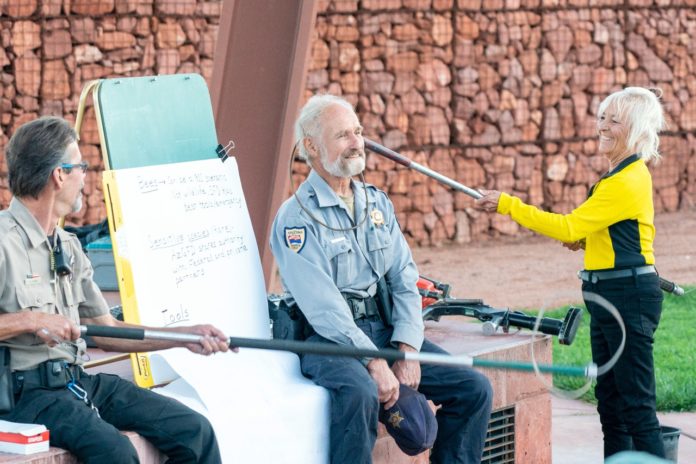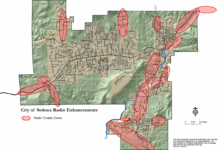
Mountain lions, bobcats and bears, oh my.
Around 20 residents turned out at the Posse Grounds pavilion on Thursday, Aug. 19, for an event hosted by the Sedona Police Department and Arizona Game & Fish Department to talk about wildlife interactions — what to do when they occur and how to prevent bad encounters.
“What we’re trying to do tonight is go over some of the aspects of living with wildlife animals in this area,” Arizona Game and Fish Warden Lee Luedeker said. “Sometimes it’s a positive influence and sometimes there can be conflicts between our wildlife population and our human population.
“People who move here are often coming from an urban setting where they have had very little interaction with wildlife in the past. In many instances they have a real panic response when in close contact with an animal.”
He said the important thing for residents to do is to determine what is an emergency and what may be a panic reaction when having an interaction with wildlife. As he pointed out, if a wild animal is in their yard, more times than not they are simply passing through.
During drought seasons, like last summer, wildlife can be they search of food and water.
“In those cases the town becomes a magnet for just about all wildlife,” he said. “There’s water here and the ability to forage, which isn’t available under drought conditions in surrounding areas. For example, grass [as he pointed to that at the pavilion] is attractive to rabbits and deer as well as other prey species. When they come into the urban areas, the predatory species that feed upon them — like mountain lions, bears and even bobcats — have to follow where that prey concentrates.”
Gene Kurz, Sedona Police Department’s animal control officer, talked about a bear incident in April 2018.
While bear sightings are rare in town, when they do occur they are taken very seriously.
On a day in April, a black bear had been spotted in a number of areas in West Sedona.
The first calls to the Sedona Police Department came in the early afternoon in the Airport Road area, then Oak Creek Boulevard. The bear was next photographed on Birch Boulevard, one street to the east and a few hundred feet south of its previous location.
The bear then made its way across a busy State Route 89A to Whole Foods.
Once authorities got to the store, the bear headed north toward Posse Grounds Park after scaling the fence of a home on San Patricio Drive. It was spotted several times in that vicinity, which led to city officials closing the Sedona Community Pool and West Sedona School going into lockdown.
“That’s where the panicked calls came in,” Kurz said. “At that time we had myself and five police officers out there looking for about an hour. I got a call to go to another address. It wasn’t being aggressive or mean. I went there and still didn’t see it. The good thing is, I think we forced it back home into the national forest.”
Subsequently, the school remained on lockdown until all the students were escorted by police to buses. And, the bear was not seen again.
Kurz added, “I assist Game and Fish. I don’t go out and trap the animals. I more or less get the information and give it to Ranger Luedeker.”
They talked about how feeding wildlife is highly discouraged. Once a wild animal finds a food source, they will often return, to the point where it may become a nuisance. In addition, they said to be cognizant that food or water left for birds may attract wildlife as well. In those cases, it’s best to put feeders off the ground or put barriers around them to discouraged other wildlife, like javelina, from eating or drinking from them.
While bears or mountain lions are a rare sight in town, other wildlife such as javelina, coyotes and rattlesnakes are far more common. In those cases, they said if the animal is in your yard and poses a danger to you, contact officials. If you come across them in the wild, they said most wildlife want to avoid human interaction. So, do your best to move away from them or use ways to scare them off without injuring them in any way.
As Luedeker and Kurz pointed out, when in the great outdoors, you’re in the wildlife’s neighborhood.
“Don’t mess with the wildlife because you could upset it and it could come after you,” Kurz said. “If you provoke it, you could end up in trouble.”





















